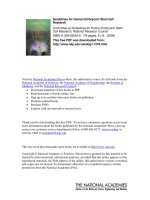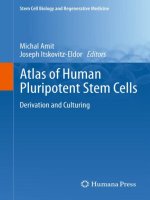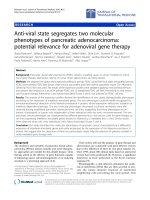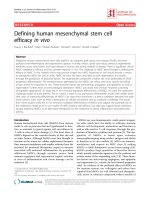Human pluripotent stem cell derived cellular vehicles for cancer gene therapy
Bạn đang xem bản rút gọn của tài liệu. Xem và tải ngay bản đầy đủ của tài liệu tại đây (4.81 MB, 158 trang )
HUMAN PLURIPOTENT STEM CELL-DERIVED
CELLULAR VEHICLES FOR CANCER GENE
THERAPY
DANG HOANG LAM
NATIONAL UNIVERSITY OF SINGAPORE
2012
HUMAN PLURIPOTENT STEM CELL-DERIVED
CELLULAR VEHICLES FOR CANCER GENE
THERAPY
DANG HOANG LAM
(B.Sc., University of Natural Science, Vietnam)
A THESIS SUBMITTED
FOR THE DEGREE OF DOCTOR OF PHILOSOPHY
DEPARTMENT OF BIOLOGICAL SCIENCES
NATIONAL UNIVERSITY OF SINGAPORE
&
INSTITUTE OF BIOENGINEERING AND NANOTECHNOLOGY
2012
I
ACKNOWLEDGMENTS
First and foremost, I would like to express my sincere thankfulness to my scientific
supervisor, Dr Wang Shu for his constant and invaluable guidance throughout my PhD
study. This thesis would not have been completed without his support, understanding and
motivation.
I am so grateful to have opportunities to cooperate with Xiao Ying Bak, Zhao Ying, Yang
Jing and Yukti Choudhury. It was unforgettable experience working with them and
together we discovered meaningful findings which will be presented in this dissertation.
Thank to all lab members Esther Lee, Ghayathri Balasundaram, Jiakai Lin, Seong Loong
Lo, Chrishan Julian Alles Ramachandra, Mohammad Shahbazi, Chunxiao Wu, Kai Ye,
Jieming Zeng and Detu Zhu for the help and the laugh they brought in my difficult time of
research. Thank to Yovita Ida Purwanti and Timothy Kwang for accompanying me during
lunchtime.
Special thank to Thomas Ngo for his help during thesis writing process.
I am also thankful to my friends including Thuc Nha, Quang Vinh, and Thanh Duong, who
always encouraged and supported me during my stay in Singapore.
Last but most important, this thesis is dedicated to my parents and brother who
unconditionally loved me and stood by me in any time of troubles.
II
TABLE OF CONTENTS
CONTENTS PAGE
Acknowledgments I
Table of Contents II
Summary VIII
List of Publications X
List of Tables XI
List of Figures XII
Abbreviations XIV
Chapter 1 Introduction 1
1.1 Gene therapy in cancer treatment 2
1.1.1 Gene therapy strategies for cancer treatment 2
1.1.1.1 Suicide gene therapy 2
1.1.1.1.1 Herpes Simplex Virus Thymidine Kinase/Ganciclovir
(HSV-tk/GCV) Prodrug System 3
1.1.1.1.2 Cytosine Deaminase-5- Fluorocytosine (CD-5-FC)
Prodrug System 4
1.1.1.2 Mutant gene correction/ Tumor suppressor gene replacement 5
1.1.1.3 Cancer immunotherapy 6
1.1.1.4 Oncolytic viruses/ Virotherapy 8
1.1.1.5 RNA interference 10
1.1.1.6 Anti-angiogenic cancer gene therapy 11
III
1.1.1.6.1 Gene therapy to inhibit pro-angiogenic pathways 12
1.1.1.6.2 Gene therapy to stimulate anti-angiogenic pathways 12
1.1.2 Gene carriers for cancer therapy 13
1.1.2.1 Viral vectors 13
1.1.2.2 Nonviral vectors 16
1.2 Stem cells- unique candidates for therapeutic platform 19
1.2.1 What are stem cells 20
1.2.1.1 Pluripotent stem cells 20
1.2.1.1.1 Embryonic stem cells 20
1.2.1.1.2 Induced pluripotent stem cells 21
1.2.1.2 Adult stem cells 23
1.2.1.2.1 Mesenchymal stem cells 23
1.2.1.2.2 Neural stem cells 23
1.2.2 Clinical relevance of stem cell vectors for cancer gene therapy 24
1.2.3 New reliable sources for therapeutic stem cells 26
1.3 Current mouse models in cancer research 28
1.3.1 Syngeneic models 28
1.3.2. Xenogeneic models 29
1.3.3 Genetically engineered models 30
1.4 Objectives 31
References 32
Chapter 2 Materials and Methods 42
2.1 Cell culture 43
IV
2.2. Mouse strains 44
2.3. Viral vector preparation and cell transduction 44
2.4 Flow cytometry analysis 46
2.5 Western blotting 46
2.6 Quantitative real-time PCR 47
2.7. Microarray and data analysis 49
2.8. In vitro migration assay 49
2.9. Biophotonic imaging of animals and organs 50
2.10. Intracranial xenografting of human cells 50
2.11. In vivo migration assay 50
2.12. Histology 51
2.13. 4T1-luc2 tumor establishment 52
2.14. iPS-NSC transplantation 52
2.15. In vivo 4T1 tumor tropism study 52
2.16. Statistical analysis 53
References 53
Chapter 3 Results: Human Embryonic Stem Cell-derived Mesenchymal
and Neural Stem Cells as Cellular Vehicles for Suicide Gene Therapy of
Glioblastoma 55
3.1. Introduction and specific aim 56
3.2. hESC-MSCs deliver suicide gene in HSV-tk/GCV system to treat
intracranial glioma 59
3.2.1. In vitro and in vivo glioma tropism of hESC-MSCs 59
V
3.2.2. Transgene expression in hESC-MSCs following baculoviral and
lentiviral transductions 60
3.2.3. Intratumor transplantation of HSVtk-expressing hESC-MSCs
transduced by baculovirus for anti-glioma therapy 61
3.2.4. Migratory HSVtk-expressing hESC-MSCs transduced by lentivirus
for anti-glioma therapy 62
3.3. hESC-NSCs deliver suicide gene in HSV-tk/GCV system to treat
intracranial glioma 67
3.3.1. Generation and characterization of NSCs derived from hESCs in
adherent monoculture 67
3.3.2. Glioma-specific migration property of NSC1 cells 68
3.3.3. Transgene expression in NSC1 cells using baculoviral vector 69
3.3.4. Tumor killing efficacy of HSVtk-expressing NSC1 cells in glioma
mouse model 70
3.4 Immunomodulation effects of MSC and NSC on tumor growth 76
References 78
Chapter 4 Results: Human Induced Pluripotent Stem Cell-derived
Neural Stem Cells as Cellular Vehicles for Suicide Gene Therapy
of Invasive Glioma and Metastatic Breast Cancer 80
4.1 Introduction and specific aim 81
4.2. Human Induced Pluripotent Stem Cell-derived Neural Stem Cells
as Cellular Vehicles for Suicide Gene Therapy of Invasive Glioma 85
4.2.1. Establishment of highly metastatic and invasive glioblastoma model
VI
in mouse using experimental lung metastasis (ELM) assay 85
4.2.2. In vitro and in vivo migration of iPS-NSCs towards invasive 2M1 88
4.2.3. 2M1 glioma growth inhibition by engineered iPS-NSCs 89
4.3. Gene therapy application of intravenously injected human iPS-NSCs
for metastatic breast cancer 96
4.3.1 In vivo distribution of human iPS-NSCs in normal mice without tumors 96
4.3.2 In vivo distribution of human iPS-NSCs in 4T1 breast tumor-bearing
mice 98
4.3.3 Systemic injection of HSVtk-expressing iPSNSCs inhibits 4T1 breast
cancer growth and metastasis 99
References 110
Chapter 5 Discussion 112
5.1 hESCs as source for MSCs and NSCs in suicide gene therapy 113
5.1.1 Baculoviruses as gene therapy vectors for human cancer 113
5.1.2 HESC- derived MSCs and NSCs as gene delivery vehicles for
glioma therapy 116
5.1.3 NSCs may be a better option for glioma therapy 118
5.2 iPS cells as source for NSCs in treating invasive glioblastoma and
metastatic breast cancer 121
5.2.1. 2M1 glioma cell line expresses similarities with human GBM 121
5.2.2 iPS-NSCs – promising gene carriers for highly metastatic cancers 122
5.3. General Discussion and Future directions 125
References 127
VII
Chapter 6 Conclusion 131
Appendix 136
VIII
SUMMARY
Cancer, also known as malignant neoplasm, is one of the leading causes of morbidity and
mortality throughout the world. Hitherto cancer therapies that have been widely accepted
and practiced are skillful surgery or microsurgery, radiotherapy and chemotherapy or
combination. Those treatments, however, are too invasive for normal and healthy tissues
and lead to further patient weakening and shortened survival. By conventional methods,
cancer is still a deadly disease with poor prognosis and the outcome is variable and
depends on many factors such as age, gender, tumor type and stage. Hence, more
efficacious system for cancer treatment is desirable.
Of all candidates, gene therapy to achieve therapeutic effects through transgene
expression is a promising treatment. Unfortunately, although gene therapy using viral
vectors produced encouraging results in various animal models, the same
accomplishments have not been observed in clinical trials owing to low gene expression
and more importantly poor distribution of vectors in patients. Stem cells have recently
become an emerging solution to serve as fascinating vehicles for gene delivery in cancer
therapy because they show favorable migration towards local and metastatic tumors. This
allows more specific targeting of transgenes to tumor sites, thus increasing efficacy.
However, one major issue with stem cell based gene therapy is the use of adult stem
cells which causes limited cell sources and variable quality of cells from donors. To
overcome these obstacles, alternative large scale production of therapeutic stem cells
must be identified. Pluripotent stem cells including embryonic stem cells and induced
pluripotent stem cells may hold the answer to this question.
IX
From that point of view, we conducted investigations to assess the feasibility of using
human embryonic stem cell (hESC)-derived neural stem cells (NSCs) and mesenchymal
stem cells (MSCs) for glioma gene therapy. We observed that human glioma bearing
mice showed noticeable reduction in tumor size and improvement in survival rate when
baculoviral and lentiviral herpes simplex virus-thymidine kinase (HSV-tk) gene was
transferred by hESC-derived MSCs and NSCs in combination with the systemic
administration of ganciclovir (GCV).
Employing an in-house invasive glioblastoma model, we further proved that induced
pluripotent stem cell (iPS cell)-derived NSCs also displayed a robust migration towards
brain tumor. This resulted in a significant tumor regression when cells were coupled with
HSVtk/GCV system.
Interestingly, using a dual-color whole body imaging technology, we discovered that iPS-
NSCs possessed a strong migration capability to established orthotopic 4T1 mouse
mammary tumors after tail vein injection. Transduced iPS-NSCs with baculoviral vector
containing HSVtk gene inhibited the growth of breast tumor and the metastatic spread of
the cancer cells in the presence of GCV.
Therefore, our study provides evidence supporting the use of stem cells as gene carriers
for anti cancer therapy and proposes pluripotent stem cells as potential alternatives to
derive therapeutic cells for this purpose.
X
LIST OF PUBLICATIONS
1.Tumor tropism of intravenously injected human-induced pluripotent stem cell-
derived neural stem cells and their gene therapy application in a metastatic breast
cancer model. Stem cells (Dayton, Ohio), Volume 30 , Issue 5 (2012)
Yang J
**
, Lam D H
**
, Goh S S , Lee E X , Zhao Y , Tay F C , Chen C , Du S ,
Balasundaram G , Shahbazi M , Tham C K , Ng W H , Toh H C , Wang S
2.Targeted suicide gene therapy for glioma using human embryonic stem cell-
derived neural stem cells genetically modified by baculoviral vectors. Gene therapy
, Volume 19 , Issue 2 (2012)
Zhao Y , Lam D H , Yang J , Lin J , Tham C K , Ng W H , Wang S
3.Glioma gene therapy using induced pluripotent stem cell derived neural stem
cells. Molecular pharmaceutics, Volume 8, Issue 5 (2011)
Lee E X , Lam D H , Wu C , Yang J , Tham C K , Ng W H , Wang S
4.Human embryonic stem cell-derived mesenchymal stem cells as cellular delivery
vehicles for prodrug gene therapy of glioblastoma. Human gene therapy , Volume 22
, Issue 11 (2011)
Bak X Y
**
, Lam D H
**
, Yang J , Ye K , Wei E L , Lim S K , Wang S
5.Combinatorial control of suicide gene expression by tissue-specific promoter and
microRNA regulation for cancer therapy. Molecular therapy: the journal of the
American Society of Gene Therapy , Volume 17 , Issue 12 (2009)
Wu C , Lin J , Hong M , Choudhury Y , Balani P , Leung D , Lam D H , Zhao Y , Zeng J ,
Wang S
**
The two authors contributed equally to the work
XI
LIST OF TABLES
TABLES PAGE
Table 4.1 qPCR for human specific HLA-A STR#54 to quantify iPS-NSCs 109
XII
LIST OF FIGURES
FIGURES PAGE
Figure 1.1 Percentage of each gene therapy strategy for clinical trials 13
Figure 3.1 In vitro and in vivo migration of hESC-MSCs towards glioma tumor 63
Figure 3.2 Transgene expression in hESC-MSCs 64
Figure 3.3 In vivo glioma therapy using hESC-MSCs transduced with
baculoviral vectors 65
Figure 3.4 In vivo glioma therapy using hESC-MSCs transduced with lentiviral
vectors 66
Figure 3.5 Neural stem cell characterization 72
Figure 3.6 In vitro and in vivo migration of hESC-NSCs towards glioma cells 73
Figure 3.7 Transgene expression in hESC-NSCs 74
Figure 3.8 Anti-glioma effect by contralaterally injection of lentiviral and
baculoviral HSV-tk expressing NSCs 75
Figure 3.9 Immunomodulation of hESC derived NSCs and MSCs promotes
tumor growth 77
Figure 4.1 ELM assay to select highly invasive U87 cells 90
Figure 4.2 Invasiveness of ELM cell lines 91
Figure 4.3 Gene expression difference between 2M1 and U87 92
Figure 4.4 In vitro migration of iPS-NSCs towards 2M1 and U87 93
Figure 4.5 Distribution of iPS-NSCs in 2M1 tumors 94
Figure 4.6 iPS-NSCs delivered an effective 2M1 tumor killing capacity 95
XIII
Figure 4.7 In vivo distribution of iPS-NSCs in normal and tumor bearing NSG
mice 102
Figure 4.8 Ex vivo imaging and near-infrared confocal microscopic imaging in
NSG mice 103
Figure 4.9 In vivo distribution of iPS-NSCs in normal and tumor bearing Balb/c
mice 104
Figure 4.10 Ex vivo imaging and near-infrared confocal microscopic imaging in
Balb/c mice 105
Figure 4.11 Distribution of DiR-labeled NSCs and free DiR dye in normal mice 106
Figure 4.12 Therapeutic effects of intravenously transplanted iPS-NSCs in 4T1
bearing nude mice 107
Figure 4.13 Therapeutic effects of intravenously transplanted iPS-NSCs in 4T1
bearing immunocompetent Balb/c mice 108
XIV
ABBREVIATIONS
5-FC 5- fluorocytosine
ATCC American Type Culture Collection
BV Baculovirus
CD Cytosine deaminase
CMV Cytomegalovirus
CNS Central nervous system
CRAds Conditionally replicating adenoviruses
EGFP Enhanced green fluorescent protein
element
ELM Experimental lung metastasis
EMT Epithelial-to-Mesenchymal Transition
EPR Enhanced permeability and retention
ESC Embryonic stem cell
FDA Food and Drug Administration
GBM Glioblastoma multiforme
GCV Ganciclovir
GDEPT Gene directed enzyme prodrug therapy
GEM Genetically engineered mouse
GFAP Glial fibrillary acidic protein
GM-CSF Granulocyte macrophage colony-stimulating factor
GPAT Gene prodrug activation therapy
hESC Human embryonic stem cell
XV
HIV Human immunodeficiency virus
HSVtk Herpes simplex virus thymidine kinase
ICM Inner cell mass
IL Interleukin
iPS cell Induced pluripotent stem cell
LV Lentivirus
MEF Mouse embryonic fibroblast
MET Mesenchymal-to-Epithelial Transition
miRNA microRNA
MRI Magnetic resonance imaging
MSC Mesenchymal stem cell
NSC Neural stem cell
NSG NOD.Cg-Prkdc
scid
Il2rg
tm1Wjl
/SzJ
RISC RNA inducible silencing complex
RNAi RNA interference
SGT Suicide gene therapy
shRNA Short hairpin RNA
SVZ Subventricular zone
TMZ Temozolomide
TNF Tumor necrosis factor
VDEPT Virus directed enzyme prodrug therapy
VEGF Vascular endothelial growth factor
VWF Von Willebrand factor
XVI
WPRE Woodchuck hepatitis virus post-transcriptional regulatory
1
CHAPTER 1
INTRODUCTION
2
1.1 Gene therapy in cancer treatment
Rapid advances in molecular technology over the last two decades have enabled the
development of gene therapy, which introduces genetic material into cells for
therapeutic purposes. Originally, gene therapy was proposed to correct genetic
disorders by transferring a normal copy of the defective gene to prevent or reverse the
course of disease, as exemplified by clear progress in the treatment of blindness and
inherited immune deficiencies. It became more apparent that the power of gene therapy
is not limited to regenerative medicine, but could also be used to treat acquired
diseases such as cancer.
1.1.1 Gene therapy strategies for cancer treatment
A large number of potential cancer gene therapies have been proposed and tested as
reviewed below.
1.1.1.1. Suicide gene therapy
Conceptually, suicide gene therapy has a major advantage over classical chemotherapy
since it involves the delivery of a gene encoding enzyme which is not toxic per se, but
can convert an inert substance or prodrug to highly toxic metabolite. Thus, if applicable,
this method could selectively abolish malignant cells without damaging normal and
healthy tissue. Although prodrug treatments for cancer in animal models with high level
of endogenous enzymes have gained certain achievements (Connors and Whisson,
1966), clinical trials have failed to deliver any benefits due to the low level of activating
enzymes in human cancers (Connors, 1995). These results led to the development of
the gene transferring system known as suicide gene therapy to enhance enzyme levels
at the target and design more efficient enzyme/prodrug couplings.
3
In the literature, suicide gene therapy (SGT) is also defined as: gene directed enzyme
prodrug therapy (GDEPT) (Marais et al., 1996); virus directed enzyme prodrug therapy
(VDEPT) (Huber and Richards, 1996); and gene prodrug activation therapy (GPAT)
(Eaton et al., 2001). All terms are to describe a two-step treatment (Niculescu-Duvaz
and Springer, 2005). In the first step, a gene encoding for a foreign enzyme (viral,
bacterial or yeast origin) is introduced by various methods into the tumor region. In the
second step, a harmless prodrug when systematically administered is converted to its
deadly counterpart by the expressed enzyme. It is crucial that the foreign enzyme needs
to be intensively expressed in tumor cells in comparison with normal tissue and blood.
Furthermore, since it is impossible for foreign enzyme to affect all tumor cells, a
bystander cytotoxic effect, which was initially described by Moolten (1986), is required
for any SGT system (Greco and Dachs, 2001). Moolten’s explanation for the bystander
phenomenon wherein the active drug kills not only the reachable tumor cells but also
the neighboring untransfected tumor cells holds the key to understanding how nearly
complete tumor eradication can be accomplished with only 5-10 % of the target cells.
Several SGT systems have been developed over the last 25 years since their inception.
Among those systems, two that have been studied extensively and tested in clinical trial
are the herpes simplex virus thymidine kinase/ganciclovir (HSV-tk/GCV) prodrug system
and the cytosine deaminase-5- fluorocytosine (CD-5-FC) prodrug system.
1.1.1.1.1 Herpes Simplex Virus Thymidine Kinase/Ganciclovir (HSV-tk/GCV)
Prodrug System
4
After phosphorylation by the enzyme HSV-tk, GCV, a nontoxic purine analogue, is
phosphorylated by endogenous kinases to become GCV-triphosphate, which interrupts
DNA synthesis and consequently causes cell death through apoptosis (Moolten and
Wells, 1990). The precise mechanisms of cell death induced by HSV-tk, however, are
still not fully understood.
During the 1990s, more than 400 papers have shown increasing evidence to support
the potential of HSV-tk/GCV (Greco and Dachs, 2001). Encouragingly, studies utilizing
adeno- and retroviral vectors were conducted in many animal models to successfully
erase liver metastases (Caruso et al., 1993), hepatocellular carcinomas (Kuriyama et
al., 1999), head and neck carcinomas (O’Malley, 1995), and glioblastomas (Takamiya et
al., 1992).
Despite its popularity in cancer research, the HSV-tk/GCV system has several
drawbacks which include nonspecific toxicity, slow killing effects, incomplete tumor
killing and a weaker bystander effect compared to other suicide gene systems
(Kuriyama et al., 1999). To overcome these limitations, efforts have been made to
modify the established HSV-tk to improve the kinetics of activation for GCV (Black et al.,
2001). TK.007 variant was designed (Preuss et al., 2011) with superior killing efficiency
and a bystander effect that had a significant improvement in anti-tumor activity
compared with conventional HSV-tk.
1.1.1.1.2. Cytosine Deaminase-5- Fluorocytosine (CD-5-FC) Prodrug System
The principle of the CD-5-FC system is that the enzyme cytosine deaminase from
bacteria or yeast, but not mammalian cells transforms non-toxic 5-FC into active 5-
5
fluorouracil (5-FU) (O'Malley et al., 1995), which is further modified to three potent anti-
metabolites (5-FdUMP, 5-FdUTP, and 5-FUTP). The resultant products induce cell
death by thymidylate synthase inhibition and the formation of (5-FU) RNA and (5-FU)
DNA complexes (Springer and Niculescu-Duvaz, 2000).
A strong bystander effect is one of the advantages of the CD-5-FC system. A significant
improvement in the survival rate has been demonstrated in human colorectal
carcinomas in nude mice when only 4% of the inoculated cells expressed CD (Trinh et
al., 1995).
1.1.1.2. Mutant gene correction/Tumor suppressor gene replacement
Cancer is a consequence of complex genetic and epigenetic alterations involving tumor
suppressor genes and oncogenes. A potential approach to treat cancer is to restore the
expression of tumor suppressor genes or to inhibit oncogene expression. Among the
candidates, p53 activities have been intensively investigated.
p53 was first described as transcription factor that positively or negatively regulates the
expression of a diverse array of target genes responsible for various pro-apoptotic Bcl-2
proteins (Bax, Bak, Puma, and Noxa), caspases, Apaf-1, PIDD, death receptors
(Fas/CD95, DR4, DR5), DNA repair proteins or the cell cycle inhibitor p21. As a result,
p53 seems to have a dictatorial effect on cell stress responses such as cell cycle arrest,
apoptosis, and senescence (Essmann and Schulze-Osthoff, 2012).
In healthy unstressed cells, p53 has a short half life and its expression remains low
owing to constant proteasomal degradation (Bossi and Sacchi, 2007). When cellular
stresses such as DNA damage, hypoxia, oncogene overexpression, or viral infection
are present, the half-life and expression of p53 increase, thus resulting in stress
6
responses to prevent cellular transformation and tumorigenesis (Bossi and Sacchi,
2007).
In approximately 50% of human cancers, however, mutations in p53 are present and
malfunctions of the p53 pathway are observed in the remaining half (Soussi et al.,
2000). Mouse models without functional p53 develop spontaneous tumors (Bossi and
Sacchi, 2007). Hence, a straightforward gene therapy to fight cancer is the restoration
of wild- type (wt) p53 function in human cancer.
In the earliest phase I study, direct intratumoral injection of a retrovirus vector
expressing the wt-p53 gene was tested in patients with non-small cell lung carcinoma
(Roth et al., 1996). There was evidence of increased apoptosis and tumor regression.
To avoid the risk of tumorigenesis by a retrovirus, adenoviral vectors have been used as
alternatives for several subsequent clinical trials for lung, bladder, ovarian, and breast
cancers (Essmann and Schulze-Osthoff, 2012).
Despite many supportive examples of therapeutic efficacy achieved by wt-p53 delivery,
the Food and Drug Administration (FDA) did not approve Advexin, a wt p53-encoding
adenovirus developed by Introgen Therapeutics. The arguments against the approval
were based on the low transfection efficiency of adenoviral vectors and the lack of
strong bystander effects.
Nonetheless, adenovirus-p53 has been approved in China for head and neck cancer
treatments in combination with radiotherapy (Shi and Zheng, 2009; Yang et al., 2010).
1.1.1.3. Cancer immunotherapy
An emerging and striking hallmark of cancer is its ability to avoid constant monitoring by
the various arms of immune surveillance and inhibit immunological killing, thereby
7
evading its own eradication (Hanahan and Weinberg, 2011). Hence, it is beneficial for
cancer treatment if a gene transferred to tumor cells can make them more highly
immunogenic. Transferring genes that encode tumor-specific antigens and inflammatory
cytokines have been investigated (Touchefeu et al., 2010).
Tumor-specific antigens, which are normally not unique among types of cancer, can
originate from oncogenic viruses such as Epstein-Barr virus and human papilloma virus
or can be self-antigens (Touchefeu et al., 2010). The mechanisms of how self proteins
in normal cells become tumor antigens in malignant cells are still unclear (Disis et al.,
2009). Possibilities include gene mutation or post-translational modification to make
them more immunogenic, such as the case with P53. Over-expressed proteins such as
HER2/neu in breast, ovarian and prostate cancers and EGFR in non-small cell lung
cancer can also serve as tumor-antigens (Disis et al., 2009). Incorrectly glycosylated
proteins such as MUC1 (mucin) are immunogenic in several types of malignant
diseases (Disis et al., 2009). Additional examples of tumor antigens include: gp100,
tyrosinase, and the MAGE, GAGE, and BAGE families. Currently, the introduction of
self-antigens by means of peptides (subdominant or cryptic epitopes), full proteins, skin
or muscle cells transfected with antigen plasmid DNA, and dendritic cells presenting
self-antigens can activate the T-cell response and produce a better outcome in cancer
patients. One future direction is the use of gene therapy to deliver those tumor-antigens.
In addition to tumor antigens, immunotherapy also utilizes vectors expressing
inflammatory cytokines such as interleukin-2 (IL-2), interleukin-12 (IL-12), tumor
necrosis factor (TNF)-α, interferon-γ, and granulocyte macrophage colony-stimulating
factor (GM-CSF) (Vachani et al., 2010)









